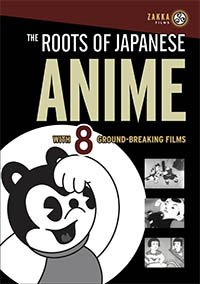The Roots of Japanese Anime until the End of WWII
Antología de animé realizados en Japón entre 1930 y 1942, en los que se retrata a la sociedad japonesa previa a la 2ª Guerra Mundial. Incluye películas realizadas por los pioneros como Noburo Ofuji, Yasuji Murata y Kenzo Masaoka, además de Águila marina de Momotaro de Mitsuyo Seo, la famosa animación bélica anunciada como el primer largometraje de animación de Japón.
Incluye:
THE VILLAGE FESTIVAL
Noburo Ofuji / 1930/ 3 min.
One of the Japan’s greatest animators, Noburo Ofuji (1900-1961) used traditional Edo chiyogami paper to give a cut-out animation version of Japanese village life.
Includes the educational song that was played via phonograph during film screenings.
SONG OF SPRING
Noburo Ofuji / 1931 / 4 min.
Another sing-a-long Edo chiyogami paper film by Noburo Ofuji.
The song, sung by an artist active in Asakura Opera, offers a delightful glimpse of 1930s pop music culture and a celebration of the seasons. Song of Spring is presented in a tinted print.
CHINKOROHEIBEI AND THE TREASURE BOX
Noburo Ofuji / 1936 / 9 min.
Noburo Ofuji, whose name now dons Japan’s most prestigious award in animation, used not cut paper but cel animation to tell this humorous tale of a mischievous pup who tries to steal the treasure of an undersea king.
THE MONKEY MASAMUNE
Yasuji Murata / 1930 / 8 min.
Yasuji Murata (1896-1966) was a pioneer in educational animation films, but is most remembered as a master of cutout animation. Many Japanese folk tales tell of a human being saving an animal and receiving a reward in return. The Monkey Masamune is one such story.
CHAMEKO´S DAY
Kiyoji Nishikura / 1931 / 7 min.
Based on a hit song by the child star Hideko Hirai from 1929, this gem provides glimpses of 1930s popular culture through introducing the typical life of a bright, energetic young girl.
DANEMON BAN-THE MONSTER EXTERMINATOR
Yoshitaro Kataoka / 1935 / 10 min.
Danemon Ban, an actual historical figure famous for his strength and leadership—and for his drinking—comically takes on raccoons posing as movie samurai. An anime strongly influenced by contemporary manga.
BENKEI AND USHIWAKA
Kenzo Masaoka /1939 / 14 min.
Kenzo Masaoka (1898-1988) is celebrated for helping introduce sound and cel animation to anime. In this enchanting work, the warrior priest Benkei and Ushiwaka (Yoshitsune Minamoto, 1159-1189), two of the most celebrated heroes in Japanese history, duel it out on Gojo Bridge.
MOMOTARO´S SEA EAGLE
Mitsuyo Seo / 1942 / 37 min.
One of early anime’s most notorious and historically important works, directed by Mitsuyo Seo, Japan’s first master of feature animation. The legendary “Peach Boy” Momotaro leads his animal vassals to bomb Pearl Harbor—and Popeye’s Bluto as the representative American demon—in a work that reveals both the brilliant manipulation of anime technique (particularly the multiplanar camera), as well as the uses of animation for wartime propaganda for children.
